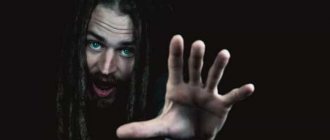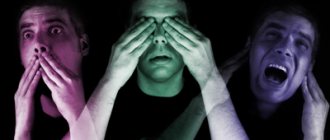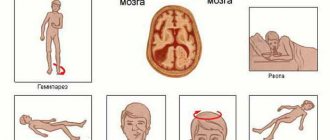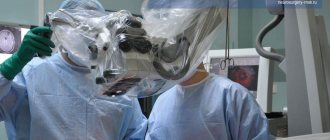Hallucinations: definition and clinical manifestations
Hallucinations should be distinguished from illusions and fantasies. Such patients see objects and hear sounds that do not really exist, and they look no less vivid and believable than real ones. The difference with illusions is that existing objects appear different to the patient. Thus, at dusk or in the dark, even a healthy person can see illusory objects due to the lack of information received. With hallucinations, attacks are often repeated: the patient hears the same voice for a long time, sees the same objects that are not in reality.
Hallucinations cannot be a variant of the norm, especially if they occur with any frequency. They represent disturbances in the perception of environmental information, and their clinical manifestations depend on the localization of the pathological process. Data enters the brain through analyzer systems: visual, auditory, sensory, olfactory, gustatory, somatosensory. If the signal is disrupted in one or more of them, the following symptoms of hallucinations may occur:
- sensations of touching the skin, movement and changing the location of the insides;
- any sounds that are absent in reality - these can be voices, music, steps, claps and others;
- foreign odors that are not noticeable to others present in the room;
- the appearance of figures, light flashes, various creatures, including non-existent ones.
Negative hallucinations should also be highlighted. In this state, a person, on the contrary, does not notice really existing signals, audio or visual. This pathology is no less dangerous than positive hallucinations, since because of it the patient may not notice objects that threaten his life. The mechanism of its development is also associated with impaired conductivity from the analyzers to the central nervous system.
Mystics - no
There is a popular belief that smelling is associated primarily with various mystical manifestations. This especially applies to the smell of death. Here there is a wide field for prophetic predictions of death, as well as a feeling of the presence of the souls of the dead.
So, scientific data does not support mystical ideas about smells. But, quite proven explanations of the origin of various odors are offered. This, of course, is not so mystical, but it will help maintain health. And, spiritually, too.
Conventionally, the origin of such “phantom” odors can be divided into several categories.
https://youtube.com/watch?v=0_O9F2QiVtI%3F
Subscribe to my youtube channel
- These are our very specific physiological diseases associated with many organs and diseases - from sinusitis to tumors. These smells are absolutely real, and, by the way, can only be felt by a sick person.
- These may be odors associated with mental disorders, in particular schizophrenia, and then these are essentially hallucinations.
- And it may be that these odors are associated with various experiences, or, for example, depressive states.
Obviously, if you smell any odors, then, provided that this is not a case of anxiety, then it makes sense to contact a specialist.
Physiological characteristics and development mechanism
Normally, information is perceived through five analyzer systems. They function in a complex and allow you to get a complete, three-dimensional picture of what is happening. Visual, auditory, olfactory, tactile and other types of stimuli are captured by different types of receptors and reach the brain in different ways. In the cerebral cortex (central nervous system), they are combined and analyzed, so a single, but complex picture appears in the human mind. Hallucinations are a complex of nervous disorders in which the information generated by the brain differs from reality. This can happen for several reasons:
- violation of signal capture at the level of sensory systems;
- disorders of the central nervous system;
- various poisonings and intoxications that lead to pathological changes in nervous tissue.
The trigger for the development of hallucinations can be various diseases of the sensory organs. Thus, in the absence of information normally received through the eyes (with cataracts, retinal detachment and other pathologies that lead to partial or complete loss of vision), the brain supplements the missing fragments. The mechanism of development of this phenomenon has not yet been fully studied, but there are assumptions about the presence of a kind of blockage in the central nervous system. If normally the brain is able to distinguish real objects from imaginary ones, then with visual impairment this function may disappear. However, hallucinations that develop in the absence of organic damage to sensory organs are more common.
Causes of hallucinations
Just like other types of illusions, olfactory ones can arise under the influence of many different provoking factors - from elementary ones that can go away on their own to very serious ones that require medical intervention.
Among the most common provoking factors it should be noted:
- diseases of a neurological and psychiatric nature;
- injuries affecting the head;
- various types of neoplasms.
Along with this, the appearance of images can also occur against the background of a violation of the integrity and normal state of the nasal mucosa. In this case, it is much easier to get rid of side effects.
Under any circumstances, the problem should be presented to a doctor for consideration. There are many people who “turn a blind eye” to olfactory illusions for many years, without realizing the danger of this condition.
It is impossible to get rid of hallucinations using other strong odors. Air fresheners also have no effect.
For example, there is a known case when a woman was haunted by the aroma of freshly dug earth for many years. She began to experience similar illusions after completing landscaping work near her home. Another patient survived a car accident, after which he was haunted by the smell of burning rubber.
The mechanism of occurrence of the disorder comes down to irritation of the secondary center responsible for recognizing odors (smelling analyzer). This is especially characteristic of epilepsy and manifests itself in the form of sensory seizures, characterized by secondary generalization. Fleeting illusions may be accompanied by other types of disorders, for example, vegetative-vascular disorders.
The main factor in the occurrence of disorders of this type is the development of pathological processes in the area of the hook of the brain.
Among the mental disorders that can lead to disorders, schizophrenia can be noted. People with this disease more often than others feel the characteristic cadaveric odors.
Possible reasons
Determining the cause of hallucinations is the first and most basic task faced by specialists at the Clinical Brain Institute. The prognosis for the patient and the tactics of his treatment depend on this, as well as the degree of danger of the disease and the possibility of complete rehabilitation. There are several groups of causes that may manifest the same clinical signs, and they can only be distinguished based on the results of more detailed diagnostics.
Psychiatric diseases
One of the main reasons why hallucinations occur, not counting various drug poisonings, is mental disorders. In this case, a violation of the perception of the environment occurs, which is why there is an inadequate assessment of the environment and response disorders. Psychoses of any etiology, schizophrenia and other mental illnesses are often accompanied by hallucinations and delusions. In some patients, these signs appear independently, but in severe forms, a lack of social adaptation, apathy, speech and memory impairment may also be observed. Specialists at the Clinical Brain Institute recommend treatment in a hospital setting using drug therapy and additional methods.
Organic changes in the brain
Hallucinations can also occur as a result of brain diseases. There are no disturbances in peripheral sensory organs (eyes, nose). When certain areas of the cerebral cortex are damaged or irritated, the patient experiences any type of hallucinations. The following pathologies can be the causes of this phenomenon:
- atherosclerosis - cholesterol deposits on the vascular walls, which reduce the diameter of blood vessels, reduce their strength and elasticity, as a result of which the supply of oxygen to the brain decreases;
- short-term increase in blood pressure - also leads to impaired circulation in some parts of the brain;
- stroke is an acute disorder of cerebral circulation, which leads to dangerous consequences;
- Dementia is an acquired, progressive disorder of cognitive function (deterioration of memory, speech), most often manifested in old age.
Hallucinations with organic brain lesions are only one of the symptoms. Depending on the extent and location of the damage, other signs may be observed: impaired motor and cognitive function, delirium, fainting and even paralysis. It is worth understanding that any disorders of the blood supply and brain function can cause dangerous complications, even a regular migraine attack.
Other diseases
Hallucinations can be either one of the main symptoms of some diseases or a nonspecific sign. Their appearance may indicate the development of pathologies of the nervous system, which include:
- delirium - mental disorders that occur with dizziness and other characteristic symptoms;
- migraines - acute attacks of headache associated with impaired cerebral circulation;
- Huntington's disease is a hereditary mental disorder that becomes especially pronounced in middle age;
- schizophrenia is a common mental disorder that can occur with more or less severe symptoms and manifest itself in attacks;
- Parkinson's disease, if it has a long progressive course;
- Alzheimer's disease - severe cases may also be accompanied by impaired brain activity.
Hallucinations can occur with varying degrees of severity. In some patients they appear as flashes of light or tinnitus, while in others they include distinct voices and lifelike figures.
Hallucinations and sleep
Many mental disorders in the initial stages manifest themselves as hallucinations only in a sleepy state. They are especially characteristic of narcolepsy, a disease characterized by various sleep disorders. Such patients periodically experience attacks of uncontrolled drowsiness, which are accompanied by decreased muscle tone and hallucinations while maintaining the ability to adequately respond to external stimuli.
Sleep-related hallucinations can be divided into two categories:
- hypnagogic - appear when trying to fall asleep and represent images of varying degrees of realism;
- hypnopompic - arise at the moment of awakening and can persist for some time, and therefore a person cannot adequately perceive the surrounding reality.
It is worth understanding that periodic occurrences of hallucinations before or after sleep are normal even for a healthy person. During this period, the perception of the environment changes, so the nervous system needs time to adapt. Most often, sleep disorders occur against the background of severe fatigue or stressful situations.
Other reasons
Hallucinations can be caused by any pathology that affects the functioning of the central nervous system. These are congenital or acquired diseases, as well as intoxications of various origins. So, this symptom can be caused by the following factors:
- use of certain types of drugs, large amounts of alcohol;
- increase in body temperature to critical levels;
- poisoning with toxic substances, including some mushrooms;
- pathologies of other organs and systems in which the process of removing toxins is disrupted and they irritate nervous tissue (liver cirrhosis, late-stage renal failure);
- severe dehydration;
- traumatic brain injuries.
Drinking large amounts of caffeine can also cause hallucinations. They will manifest themselves in a mild form (tinnitus, the appearance of spots in the field of vision) and will quickly stop, but they should not be allowed to reappear.
How to treat olfactory hallucinations after coronavirus and more
First of all, it is necessary to differentiate what the smell disorder is associated with - diseases of the ENT organs or brain damage. In the first case, treatment is carried out by an otolaryngologist; it is with this specialist that the diagnostic search should begin. And in the second case, the therapeutic program is drawn up by a neurologist.
After Covid infection, anti-inflammatory and immunomodulatory therapy is usually sufficient. Sometimes physiotherapy may also be prescribed in combination. When polyps are identified, they are removed endoscopically. If hallucinations occur due to brain damage, then conservative treatment with nootropic, metabolic, vascular and other drugs is used.
If you are faced with olfactory hallucinations, then do not delay your visit to the otolaryngologist. Timely identification of the causes of such a disorder will allow timely initiation of targeted treatment and avoid serious complications. At the Ear, Nose and Throat Clinic, consultations are conducted by qualified specialists who regularly improve their knowledge taking into account the latest advances in the field of medicine. Make an appointment at a convenient time!
Seeing a doctor in a timely manner will help maintain your health.
Don't delay treatment, call right now. We work around the clock. tel. (24 hours a day)
Classification of hallucinations
Hallucinations are a complex disorder. Their clinical signs vary from patient to patient, and in some cases remain invisible to others. For their timely detection, as well as for the convenience of diagnosis, classifications have been developed according to various criteria. First of all, true and pseudohallucinations are distinguished. The first of them are realistic and fit harmoniously into the surrounding environment. In the patient’s consciousness they do not differ from real objects. Pseudohallucinations can be distinguished by the following symptoms:
- look foreign, differ from real objects, and a person understands their difference from real sounds, objects, sensations;
- auditory hallucinations are sounds that the patient hears not with his ears, but they appear inside his head or stomach;
- changes in the patient’s behavior - due to the unreality of what is happening to him and the belief that only he can experience such hallucinations, therefore he associates them with fictitious persecutors.
Pseudohallucinations occur during internal disorders and often indicate the development of schizophrenia. Patients understand that the situation that is happening to them is far from normal, and that other people do not experience the changes that are happening to them. However, patients do not call these phenomena hallucinations - more often you can hear about alien persecution and receive other unrealistic explanations.
A separate classification identifies several types of hallucinations according to the methods of their perception:
- auditory - any sounds and voices;
- visual - appear in empty space, and are not a distorted perception of other forms and objects (as with illusions);
- olfactory - the appearance of odors that no one except the patient perceives;
- tactile (more often associated with age-related mental changes or drug use) - itching, tingling of the skin, then visual hallucinations may also appear in the form of insects and other explanations for these sensations;
- gustatory - often a symptom of poisoning delirium, in which the patient is afraid of being poisoned;
- visceral - patients claim that they have a certain object inside them.
Hallucinations can occur separately or in combination. Their diagnosis is difficult, since they largely rely on data from people with mental disorders. According to statistics, visual forms appear more often in acute psychoses, and auditory forms more often in chronic forms of schizophrenia, but in most cases the type of perception of hallucinations does not have any particular diagnostic significance. It is important to distinguish which varieties can harm the patient and others, and which can be considered safe.
- Imperative hallucinations are imperative in nature. Patients may hear instructions for action in their own heads, but are afraid to admit it. This is the most dangerous variety because it can cause aggression.
- Associative - complex hallucinations. In such patients, visual images are complemented by auditory accompaniment and vice versa.
- Reflex - characterized by the presence of a real stimulus that is perceived incorrectly. They should be distinguished from illusions: in this case, the patient can perceive both the stimulus and the hallucination.
- Extracampal - with such hallucinations, the patient claims that he sees objects that are outside his field of vision (behind or to the side). All varieties, except the first, usually do not pose a danger to the patient and his environment.
Hallucinations can occur in attacks or accompany the patient constantly. In the second case we are talking about hallucinosis syndrome. Voices or images often remain the same: you can hear about a specific voice that sounds in a person's head.
Causes of unpleasant symptoms
“At times I smell odors that are not there,” a complaint of this kind should be considered with special care, since the patient may be infected with pathological diseases. The most common diseases usually include the following:
- pulpitis, periodontitis and dental caries;
- sinusitis - sinusitis or sinusitis;
- chronic tonsillitis;
- foul runny nose.
As a rule, all of the above pathologies are accompanied by the release of purulent masses, which can cause an unpleasant odor in the patient. However, people around you are unlikely to feel it, except during close contact, for example, kissing.
Diagnostic and treatment methods
Diagnosing hallucinations is a difficult task, so it is important to collect medical history from the patient and those around him. A team of professionals works at the Clinical Brain Institute: doctors will be able to determine the cause of this symptom and prescribe an effective treatment regimen, as well as provide the necessary consultations for the patient’s relatives. Examination methods are selected individually, depending on the data obtained. If the patient has a history of various bruises, open or closed craniocerebral injuries, as well as organic pathologies of the brain, the diagnosis should continue in this direction. In general, the general scheme applies:
- psychiatric examination - consultation includes a conversation with a specialist, as well as samples and tests;
- MRI or CT scan of the brain;
- Polysomnography is a method for diagnosing sleep disorders, also performed at the Clinical Brain Institute.
Treatment is selected individually. If hallucinations are caused by drugs or alcohol, you can get rid of them only after giving up their cause. Inpatient treatment is recommended, and its goal is to cleanse the body of toxins and reduce dependence on drugs and alcohol. In cases where hallucinations occur against the background of severe fatigue, a long rest is indicated, after which they pass. In other cases, drug treatment is necessary:
- neuroleptics are the main method of relieving the manifestations of mental disorders in adults and elderly patients;
- antiparkinsonian drugs, if hallucinations are caused by this particular disease;
- antidepressants - reduce the likelihood of complications;
- means to improve nutrition and blood supply to the brain.
Antipsychotics are a broad group of medications used for various types of mental disorders. Previously, their use was accompanied by a large number of side effects, but new generation drugs are safer for patients. They are mainly prescribed to older people, as well as for Alzheimer's disease. It should be understood that therapy should be carried out under the supervision of a doctor and the patient’s relatives. At the initial stage, improvements often occur, which are accompanied by a feeling of euphoria. This may lead to a desire to cancel any treatment, which is strictly not recommended. With the proper use of medications, significant results can be achieved, some manifestations of schizophrenia and psychosis can be stopped, and the patient’s mental state can be stabilized for a long time. In acute forms and significant impairment of perception, treatment is aimed at eliminating signs of aggression - even if it is impossible to completely restore the functioning of the nervous system, it is important to reduce the risks of unwanted behavior, protecting the patient and others.
The Clinical Brain Institute offers diagnostic and treatment services for patients with hallucinations. There are all conditions for a comprehensive examination, and you can also get advice from a psychiatrist. Depending on the data obtained, treatment can take place at home or in a hospital, and its success depends on many factors: the cause of hallucinations, the age of the patient and his lifestyle, as well as the reversibility of the pathological process.
Clinical Brain Institute Rating: 4/5 — 11 votes
Share article on social networks
Causes of unpleasant odor
The perception of smell depends on special olfactory receptors, which are localized in the structure of the nasal mucosa.
They are the ones who respond to specific aromatic stimuli. However, this is only the first section of the analyzer.
The impulse then travels to the part of the brain that is responsible for evaluating sensations, namely the temporal lobes.
If a person has a feeling of smell in the absence of it, this indicates a certain pathology.
In this case, otolaryngological and dental problems can be suspected. These include the following:
- foul runny nose;
- chronic tonsillitis;
- sinusitis – frontal sinusitis, sinusitis;
- carious lesions of teeth, periodontitis, pulpitis.
The listed pathologies are characterized by the appearance of purulent masses that cause an unpleasant odor.
A similar situation when a person says “I smell a bad smell” can occur with lesions of the digestive system. In this case, the cause may be gastritis, ulcer, pancreatitis or cholecystitis.
When food gets into the digestive organs, there are problems with its digestion.
During reflux or belching, unpleasant odor molecules are released.
Others may not even notice that a person has such problems.
Some people have a low olfactory threshold. They sense smells much better, so in some cases they may encounter misunderstandings from others. If the aroma is too weak, other people will not notice it.
The cause of such problems may be a respiratory infection, which is accompanied by inflammatory damage to the nasal mucosa, or other disorders in the body. These include the following:
- endocrine disorders – hypothyroidism, diabetes;
- the use of certain medications or intoxication with harmful substances;
- hormonal fluctuations - observed during pregnancy, menstruation and menopause;
- presence of bad habits – smoking, excessive drinking, drug addiction;
- systemic pathologies - in particular scleroderma;
- neuroses or depression;
- tumor lesions of the brain;
- psychoses - in particular schizophrenia;
- traumatic brain injuries;
- epilepsy.
It is important to consider that there is such a thing as phantom odors.
Which doctor should I contact?
If you suddenly begin to smell a smell from a distance or it seems to you that you feel an aroma that is not actually there, then you should immediately visit the clinic for a comprehensive diagnosis of the whole body. Otherwise, you risk finding out about an unpleasant illness when it is too late. Any self-medication options in this case are highly not recommended.
In most cases, people turn to a therapist or otolaryngologist for help. Diseases of the ENT organs in this case are considered the most common option, but one should not exclude the fact that a specialist may send you to another doctor if he does not find a problem in his area. For diagnosis, modern equipment or a classic examination of the respiratory system and oral cavity are used.
If we are talking about any psychological disorders, then diagnosis can become several times more complicated, especially if the patient experiences phantom odors. In addition to the medical history, the main tool for identifying psychological diseases is special equipment for diagnosing the nervous system.
Auditory
Auditory hallucinations in schizophrenia are one of the most common symptoms. Patients hear voices that either give instructions, or swear, or simply comment on the person’s actions. Entire dialogues can unfold in the patient’s head, to which he becomes an involuntary listener.
There are several types of auditory hallucinations:
- acoasms - noise, shots, music, crackling noises, steps, etc.;
- phonemes - fragments of words or syllables;
- one-sided - just voices;
- two-way - dialogue with voice;
- verbal - the voices of non-existent people.
By analogy with visual hallucinations, hypnagogic and hypnopompic hallucinations are distinguished. But imperative ones are among the most dangerous for the patient and others. They are associated with the orders that a person receives from the voice. He can order both to attack someone and to harm himself.
Imperative hallucinations can become the basis for a person’s forced hospitalization in a psychiatric hospital.
In medical practice, there are cases where mothers, under the influence of voices, killed their own children. Therefore, the patient should be shown to doctors as soon as possible. The problem is that he himself may not consider himself sick.
From the outside, it is not easy to identify auditory hallucinations, but you can notice that the person is constantly talking to himself, listening, speaking in a whisper and asking again. He will also most likely often look from left to right, trying to find his “interlocutor”.
When else do hallucinations occur?
One of the problems with this symptom is that people are afraid to talk about it. Often they understand that something is wrong with them, but they do not dare to admit it to others, because they do not want to be branded as schizophrenics. However, hallucinations are not such a specific symptom.
It is observed when:
- bipolar affective disorder;
- epileptic psychoses;
- alcoholic delirium;
- local brain lesions;
- neurodegenerative diseases;
- acquired deafness, etc.
Hallucinations are also artificially induced by people using hallucinogenic mushrooms and pills.
Any form of schizophrenia requires differential diagnosis, even if most of the typical signs for this pathology are observed.
What does Corona smell like?
As a rule, the side effect begins with a loss of smell, although for some it is immediately distorted. And here there is a huge variety of “aromas” - some are haunted by the constant aroma of burning or rotten eggs, others cannot get rid of the obsessive stench of their own sweat. There are also patients who have the smell of cigarettes in their noses, even though they do not smoke!
Problems with the sense of smell have already become a specific symptom of Covid-19, directly indicating infection. It is typical that the nose does not run, it is not even always stuffy, but the perception of smells changes.
Phantosmia is the name given to the ability to sense imaginary, non-existent odors. It is based on fantasy, deception, and the illusion of smell.
Virologists believe that olfactory illusions are only delayed consequences of Sars-CoV-2 - essentially the same residual phenomenon as, for example, weakness after a cold or flu. Reports of distorted odors after coronavirus began to appear mainly in the fall, during the second wave.
How long does it last
On average – 2 weeks, sometimes it lasts up to a month. In more rare cases, recovery takes 2 or even 3 months. One thing is for sure - the sense of smell will return, for which there is a scientific explanation.
The coronavirus attacks supporting nerve cells, not the neurons themselves. These cells are regularly renewed, and the function of the nerve fibers is restored. This is the mechanism of damage that distinguishes the loss of smell in Covid-19. In the case of colds and acute respiratory viral infections, it is caused by swelling of the nasal mucosa.
Note that the taste of products is recognized not only by the receptors of the tongue, but also by the olfactory epithelium located in the upper parts of the nasal cavity. It plays a key role in the perception of taste characteristics.
In fact, we taste with our nose, and this is easy to check. You just need to eat, for example, a lemon, and hold your nose while doing so. It will be sour, but the specific citrus taste will disappear.
The signal of the beginning of recovery is often just distorted odors caused by partial regeneration of nerve cells. They are already beginning to sense aromas, but not in full, and not all.
If everything starts to smell the same, strange or unpleasant, it means that soon your sense of smell will return completely. Many experts argue that there is no point in rushing recovery, and you just need to wait a little.
What are hallucinations
Hallucinations are false images that appear in the mind without a real external stimulus. The patient can see, hear, touch or feel with other senses something that is not in the real world. At the same time, it is quite difficult to convince a person that the images he perceives are just an illusion, especially in cases where they are accompanied by delusional ideas.
Hallucinations usually occur in paroxysms. They only go away after taking special medications. In rare cases, they disappear without medical intervention, but soon appear again. Sometimes hallucinations are chronic and do not disappear even during remission.
Pseudohallucinations
Initially, pseudohallucinations were called mental and apperceptive hallucinations. Their main difference from the real ones is that the patient understands their unreality. He sees images, usually fantasy, but they are devoid of spatiality, and most importantly, the person realizes that these are just illusions.
Main features of pseudohallucinations:
- Inward orientation. They are generated by subjective perception, and therefore they are not perceived as real objects of the external world.
- Significance. They are experienced much more powerfully than true hallucinations, since they represent meaningful images.
- Artificiality. The patient has no power over them, therefore he believes that they are inspired from the outside, introduced into his head by aliens, wizards, etc.
Visual and auditory pseudohallucinations are common. The following clinical case can be cited as an example. A man with schizophrenia felt as if a gun was flying in his head, about to fire under the influence of external forces. He believed that they wanted to enslave him and were threatening to pull the trigger using a remote control.
Due to the fact that the patient is aware of the unreality of the image or voice, he rarely consults a doctor with such a problem, which leads to the progression of the pathology.
With auditory pseudohallucinations, an unusual arrangement of sounds is noted. So, the patient can hear someone talking in his stomach. At the same time, he distinguishes echoes or echoes. Voices may talk or give orders. The Kannabich-Liozner symptom is often observed when the patient hears in his head the calls of strangers addressing him in a diminutive form.
Much less often, but still sometimes there are other types of pseudohallucinations:
- motor - the patient is forced to move;
- olfactory - artificially created smells and tastes;
- speech motor - the patient is forced to say something.
According to the stories of patients, pseudohallucinations resemble memories, however, if the latter arise consciously, then the former arise arbitrarily and chaotically.
Distinguishing pseudohallucinations from true hallucinations in schizophrenia is not easy. The patient may believe in the existence of both. However, false visions are not identified with real objects, while with hallucinations a person, even if he sees devils or aliens, believes that they are really present in the world around him.
There are other differences too. Pseudohallucinations usually appear in the morning, but true ones can accompany a person around the clock. False images do not have clear outlines or localization, and real hallucinations appear in the form of specific objects that have a spatial orientation.
These symptoms can also be differentiated by the patient’s behavior. With pseudohallucinations, he is usually depressed and apathetic, and with true hallucinations, he is agitated and aggressive.











